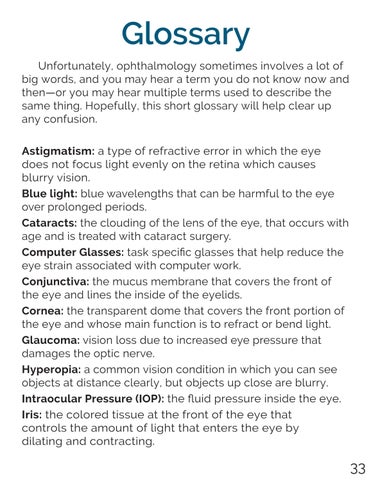Glossary Unfortunately, ophthalmology sometimes involves a lot of big words, and you may hear a term you do not know now and then—or you may hear multiple terms used to describe the same thing. Hopefully, this short glossary will help clear up any confusion. Astigmatism: a type of refractive error in which the eye does not focus light evenly on the retina which causes blurry vision. Blue light: blue wavelengths that can be harmful to the eye over prolonged periods. Cataracts: the clouding of the lens of the eye, that occurs with age and is treated with cataract surgery. Computer Glasses: task specific glasses that help reduce the eye strain associated with computer work. Conjunctiva: the mucus membrane that covers the front of the eye and lines the inside of the eyelids. Cornea: the transparent dome that covers the front portion of the eye and whose main function is to refract or bend light. Glaucoma: vision loss due to increased eye pressure that damages the optic nerve. Hyperopia: a common vision condition in which you can see objects at distance clearly, but objects up close are blurry. Intraocular Pressure (IOP): the fluid pressure inside the eye. Iris: the colored tissue at the front of the eye that controls the amount of light that enters the eye by dilating and contracting.
33










